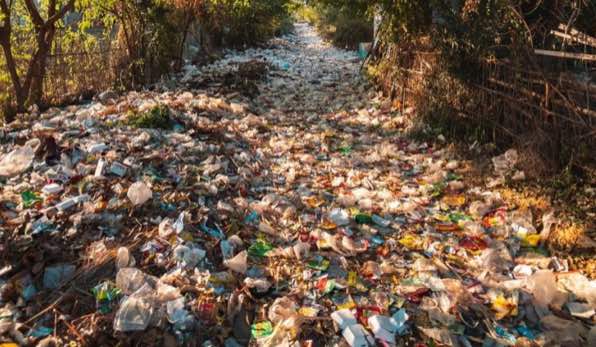A multidisciplinary team from Lawrence Berkeley National Laboratory (Berkeley Lab) has created a plastic that can be disassembled at a molecular level using an acidic solution. Then, it can be reassembled with a new color, texture, and shape, again and again. Unlike traditional plastic, which can only be recycled two or three times at most, this material, called poly(diketoenamine), or PDK, is infinitely recyclable.
Why is this an important development? Plastics are creating a waste management crisis. Globally, we produce 380 million tons of plastic annually, much of it for single use. Despite the presence of a recycling emblem on many plastic items, less than 9% is recycled. Much of the plastic intended for recycling is shipped to Asia, creating a considerable transportation footprint. At the heart of the issue is that plastic — at least until now — has not been infinitely recyclable and virgin plastic is often cheaper for manufacturers than recycled.
“Most plastics were never made to be recycled,” said lead author Peter Christensen, a postdoctoral researcher at Berkeley Lab’s Molecular Foundry. “But we have discovered a new way to assemble plastics that takes recycling into consideration from a molecular perspective.”

A Financial Incentive for Recycling
A new study from Berkeley Lab indicates that PDK could be commercially viable, making it more likely to hit store shelves sometime soon. The study found that virgin PDK is relatively expensive to make but that recycling costs are similar to those of PET and HDPE. But PDK recycling costs are lower than those of polyurethane, which curbside recycling programs don’t accept. This price difference would make recycling PDK far more appealing than landfilling it.
“We’re talking about materials that are basically not recycled,” said Scown. “So, in terms of appealing to manufacturers, PDKs aren’t competing with recycled plastic – they have to compete with virgin resin. And we were really pleased to see how cheap and how efficient it will be to recycle the material.”
Because virgin plastic is so cheap, manufacturers have little incentive to use recycled plastic. And the cost of recycling has largely fallen on municipalities to shoulder because there is low demand and value for recycled plastic. Manufacturers don’t have much motivation to make plastics more recyclable because they aren’t responsible for end-of-life product disposal. It’s a vicious cycle that encourages waste. Thus, most plastic — recyclable or not — ends up in landfills, at waste incineration plants, or as litter.
Introducing PDKs in Products
The Berkeley Lab team has created models to understand the best use of PDKs by manufacturers. They conclude that the ideal applications are ones where the manufacturer takes back the product at the end of life, like electronics and automobile manufacturers. Many of these companies have recycling, trade-in, and take-back programs. This model would allow manufacturers to reap the benefits of next-generation polymers in their products through long-term cost savings and sustainable branding.
After introducing PDKs in durable goods like electronics and cars, Berkeley Lab researchers hope to expand their use into single-use products like packaging. Extended producer responsibility is an approach that involves manufacturers in the entire lifecycle of a product, including end-of-life. This approach helps embrace the circular economy and is a radical shift from the status quo, especially in the United States. Without extended producer responsibility, most manufacturers will opt to use the cheapest materials, regardless of the environmental and social impacts. This is because the waste management costs and environmental issues in the U.S. typically don’t fall on manufacturers.
“Some countries have plans to charge hefty fees on plastic products that rely on non-recycled material,” says Corinne Scown of the Berkeley Lab team. “That shift will provide a strong financial incentive to move away from utilizing virgin resins and should drive a lot of demand for recycled plastics.”
Governmental policies and consumer demand can help fuel the change needed to drive greener business practices. “These days, there is a huge push for adopting circular economy practices in the industry. Everyone is trying to recycle whatever they’re putting out in the market,” said Nemi Vora, a postdoctoral fellow at Berkeley Lab. “We started talking to industry about deploying 100% infinitely recycled plastics and have received a lot of interest.”
Creating Recycling Infrastructure
The United States, the EU, New Zealand, Australia, Japan, and South Korea lack the infrastructure necessary to recycle waste properly. As a result, many recyclables were being shipped to Asia for processing. In 2018, China instituted a ban on recycling imports.
After China’s bans, many developed countries then diverted their waste to Southeast Asia, including Thailand, Vietnam, Malaysia, and Indonesia, which lack the infrastructure, knowledge, and policies to handle it properly. Thus, the burden on the developed world’s trash is still ending up on beaches, waterways, and landfills overseas.
Ultimately, if PDKs prove to be the smartest path forward, plastics recycling needs to be reinvented for processing materials that were designed to be recycled. Additionally, domestic recycling infrastructure will need to be created so that the materials are processed far closer to the country of origin. Then we can begin to truly close the loop on plastics recycling.
The post Will Infinitely Recyclable Plastic Soon Be Available? appeared first on Earth911.








